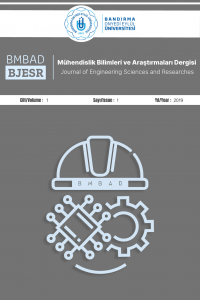Kötü Amaçlı Yazılım Türlerinin Tespitinde Kullanılan 1B Verilerin 2B Barkod Türlerine Dönüştürülerek Derin Ağlarla Analizlerinin Gerçekleştirilmesi
Özellik Çıkarma, Kötü Amaçlı Yazılımlar, 2B Barkod Türleri, Derin Öğrenme
Conversion of 1D Data Used in Detection of Malware Types to 2D Barcode Types and Analysis with Deep Networks
Feature Extraction, Malware, 2D Barcode Types, Deep Learning,
___
- M.D. Yılmaz “Malware classification with using deep learning”, Comput. Informatics, vol. 2, no. 2, pp. 21–40, 2022.
- U.H. Tayyab, F.B. Khan, M.H. Durad, A. Khan, and Y.S. Lee “A Survey of the Recent Trends in Deep Learning Based Malware Detection”, J. Cybersecurity Priv., vol. 2, no. 4, pp. 800–829, 2022.
- M. Toğaçar “Siber Saldırılara Karşı Kullanılan Makine Öğrenme Yöntemlerinin Web Uygulamalarında Güvenlik Etkinliğinin Ölçümü”, Gazi Üniversitesi Fen Bilim. Derg. Part C Tasarım ve Teknol., vol. 9, no. 4, pp. 608–620, 2021.
- M.S. Akhtar and T. Feng “Detection of Malware by Deep Learning as CNN-LSTM Machine Learning Techniques in Real Time”, Symmetry (Basel)., vol. 14, no. 11, pp. 2308, 2022.
- D. Yuxin and Z. Siyi “Malware detection based on deep learning algorithm”, Neural Comput. Appl., vol. 31, no. 2, pp. 461–472, 2019.
- V. Ravi, M. Alazab, S. Selvaganapathy, and R. Chaganti “A Multi-View attention-based deep learning framework for malware detection in smart healthcare systems”, Comput. Commun., vol. 195, pp. 73–81, 2022.
- J. Pavithra and S. Selvakumara Samy “A Comparative Study on Detection of Malware and Benign on the Internet Using Machine Learning Classifiers”, Math. Probl. Eng., vol. 2022, pp. 1–8, 2022.
- T. Carrier, P. Victor, A. Tekeoğlu, and A. Lashkari “Malware Memory Analysis”, UNB, 2022.
- D. G. Tec-it “Data Matrix (ECC200) - 2D Barcode”, 2022.
- C. Center “Aztec Codes”, url: https://www.cognex.com/resources/symbologies/2-d-matrix-codes/aztec-codes, (Erişim Tarihi: 12/03/2023).
- A. Zafar “A Comparison of Pooling Methods for Convolutional Neural Networks”, Appl. Sci., vol. 12, no. 17, p. 8643, 2022.
- C. Garbin, X. Zhu, and O. Marques “Dropout vs. Batch Normalization: An Empirical Study of Their Impact to Deep Learning”, Multimed. Tools Appl., vol. 79, no. 19, pp. 12777–12815, 2020.
- T. Huang, J. Chen, and L. Jiang “DS-UNeXt: depthwise separable convolution network with large convolutional kernel for medical image segmentation”, Signal Image Video Process, 2022.
- M.R.A. Bacha, A. Oukebdane, and A. Hafid Belbachir “Implementation of the zero-padding interpolation technique to improve angular resolution of X-ray tomographic acquisition system”, Pattern Recognit. Image Anal., vol. 26, no. 4, pp. 817–823, 2016.
- R. Nirthika, S. Manivannan, A. Ramanan, and R. Wang “Pooling in convolutional neural networks for medical image analysis: a survey and an empirical study”, Neural Comput. Appl., vol. 34, no. 7, pp. 5321–5347, 2022.
- G.C. Cardarilli et al. “A pseudo-softmax function for hardware-based high speed image classification”, Sci. Rep., vol. 11, no. 1, p. 15307, 2021.
- D. Alimov “Aztec Code generator”, url: https://pypi.org/project/aztec-code-generator/, (Erişim Tarihi: 21/02/2023).
- X. Ling Yushulx “Barcode Image Composer”, url: https://pypi.org/project/barcode-image-composer/, (Erişim Tarihi: 21/02/2023).
- E. Başaran “Classification of white blood cells with SVM by selecting SqueezeNet and LIME properties by mRMR method”, Signal Image Video Process., vol. 16, no. 7, pp. 1821–1829, 2022.
- A. Çalışkan “Detecting human activity types from 3D posture data using deep learning models”, Biomed. Signal Process. Control, vol. 81, p. 104479, 2023.
- A. Ari “Multipath feature fusion for hyperspectral image classification based on hybrid 3D/2D CNN and squeeze-excitation network”, Earth Sci. Informatics, vol. 16, no. 1, pp. 175–191, 2023.
- M. Toğaçar, B. Ergen, and Z. Cömert “Detection of weather images by using spiking neural networks of deep learning models”, Neural Comput. Appl., vol. 33, no. 11, pp. 6147–6159, 2021.
- M.H.L. Louk and B.A. Tama “Tree-Based Classifier Ensembles for PE Malware Analysis: A Performance Revisit”, Algorithms, vol. 15, no. 9, p. 332, 2022.
- M. Dener, G. Ok, and A. Orman “Malware Detection Using Memory Analysis Data in Big Data Environment”, Appl. Sci., vol. 12, no. 17, p. 8604, 2022.
- A. Mezina and R. Burget “Obfuscated malware detection using dilated convolutional network”, 14th Int. Congr. Ultra Mod. Telecommun. Control Syst. Work., p. 110–115, 2022.
- M.A. Talukder et al. “A dependable hybrid machine learning model for network intrusion detection”, J. Inf Secur. Appl., no. 72, p. 103405, 2023.
- ISSN: 2687-4415
- Yayın Aralığı: Yılda 2 Sayı
- Başlangıç: 2019
- Yayıncı: Bandırma Onyedi Eylül Üniversitesi
Tag: Blokzincirinden Esinlenilen Veri Yapısı
Alpay DORUK, Savaş TAKAN, Fatih SOYGAZİ, Zeynep DEMİRTAŞ, Elnur AKKURT
Haploid ve Diploid Mısırların Aktif Öğrenme Yaklaşımı ile Sınıflandırılması
Endüstriyel Kontrol Sistemlerinde Yenilikçi Anomali Tespit Sistemlerinin İncelenmesi
Nursel ÖKSÜZ, Özge KABCUK, Mehmet SAVAŞ, İsmail KOÇAK
A case study: Understanding The Nature of Memories Architectures in FPGAs to Built-up Bi-CAM
Halit ÖZTEKİN, İhsan PEHLİVAN, Abdelkader LAZZEM
Ali Berk YALINKILIÇ, Saffet VATANSEVER
Evrişimli Sinir Ağlarında Transfer Öğrenmesi ile GAN tarafından Üretilen Sahte Görüntü Tespiti
Ece ECEMİŞ, Kemal GÜNER, Umut KURAN, Emre Can KURAN
Yapay Zekâ Yaklaşımlarını Kullanarak Retinopati Hastalığının Tespiti
